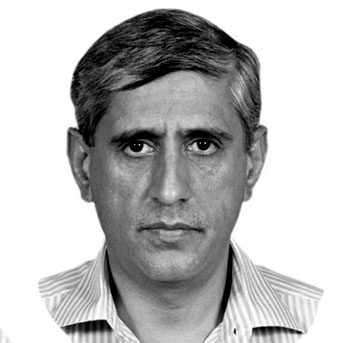New hope for South Asia
HOPE springs eternal in human bosom and South Asia might just be lucky enough to experience the post-Biden peace dividends that so far have defied the region.
The Biden Presidency instills a new hope of a Kantian world of peace and cooperation as opposed to cut throat Hobbesian competitiveness of Trump era.
South Asia has become an arena of Sino-USA rivalry that plays out in the shape of a constant standoff against China and Pakistan.
India has taken over the mantle of the US surrogacy with alacrity aligning its strategic interests with its ideological values.
These values of late have seen a dangerous shift towards right wing religious extremism.
The Hindutva creed of social and political exclusion for all communities other than Hindus is driving India towards a political xenophobia.
The mistakes of the past and intractable conflicts like Kashmir are not so insuperable barriers to the peace as is the communalization of the foreign policy by Indians as a mirror image of their domestic policy.
Indian polity has been captured by a far right political creed based on Hindu religion’s extremist and militant front called Rashtriya Swayamsevak Sangh (RSS).
The current Modi-led BJP government is a fig leaf and a front for the exclusionary and racist political creed of RSS.
BJP represents a mix of corporate greed and religious exclusivism pandering to the divisive populism predicated upon atavistic identity politics.
The above ideological orientation has resulted in militarization of Indian foreign policy that now threatens regional peace.
The illegal annexation of disputed State of Jammu and Kashmir by Indian government and a military standoff with China in Ladakh has resulted in a no war and no peace like situation in Kashmir and Ladakh.
What would it take to reconcile the apparently irreconcilable positions of China, India and Pakistan on contentious issues to reap the fruits of peace in South Asia? The cost of disrupted trade and economic activity in South Asia runs into trillions of dollars because of a constant state of conflict in the region.
According to a World Bank Report in 2018 the potential annual India-Pakistan trade stands at $37 billion which means that both countries have lost around $350 billion in the last decade, considering the fact that the present trade is a measly $2 billion annually.
The new US administration is expected to depart from the Trump era knee jerk policy making to value geo-economics and human security above an enervating race for geopolitical one upmanship.
The US Secretary of State Antony Blinken’s clear message to Ashraf Ghani to take the intra-Afghan dialogue seriously alongwith Secretary of Defence Lloyd Austin’s laudatory statement about Pakistan’s role in Afghan peace indicate change in US priorities.
The recently changed tone and tenor of Indian leadership while responding positively to Pakistan’s peace overtures betokens a back channel US nudge for the peace in the region.
The above development is noteworthy considering the fact that America under Trump had used India as a willing regional surrogate to counter China and its regional connectivity initiatives like Belt and Road (BRI) and China Pakistan Economic Corridor (CPEC).
Despite angling for competing security and economic alliances like Quad, the USA and its allies have started discussing the possibilities of an economic corridor to rival the Chinese BRI.
Though the Quad and East Asian allies of USA still hold a nebulous view of the economic corridor vis a vis a concrete reality of BRI still the possibility of such an economic enterprise has started a serious rethink amongst the Euro-Atlantic strategic community.
The recently concluded Islamabad Security Dialogue featured Prime Minister Imran Khan emphasizing the importance of human security and economic sinews under the umbrella of comprehensive national security.
It was a refreshing departure from the erstwhile emphasis on traditional notion of security that relied on hard power of the state.
The pièce de résistanceof the dialogue was the COAS address in the concluding session where he laid out a fresh vision of regional peace and security based on burying the hatchet and moving on with peace parleys to resolve the contentious issues between the two estranged neighbours.
Greater responsibility devolves upon USA to act as a peace balancer in South Asia by cooling the visceral fires of religious nationalism in India and to wean it away from a confrontational posture towards Pakistan.
The peace between India and Pakistan in addition to peace dividends to both countries would be of tremendous benefit to Afghan peace also.
India and Pakistan which are presently involved in a mutually enervating hybrid war could redirect their energies towards stabilization of Afghanistan and its economic integration with South Asia.
India therefore instead of behaving as a spoiler for Afghan peace could act as a stabilizing influence helping USA resolve the intractable Afghan conflict.
It is time geo-economics trumped geopolitics in South Asia and the regional connectivity unleashed the creative potential of the region.
The recent strategic cooperation agreement between China and Iran also portends a positive trajectory of peace and economic cooperation in the region.
India and the USA can make use of these new winds of change blowing in the region to tap into the regional connectivity grid to stake a claim to the untapped economic potentialities in the region.
The USA under new democratic leadership looks serious to honour its commitments to liberal internationalism.
It has a clear choice: to remain embroiled in conflicts costing trillions of dollars to its taxpayers or to become part of a peace and economic connectivity grid to help everyone reap the benefits of peace.
— The writer is the Acting President Islamabad Policy Research Institute.










